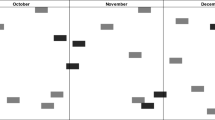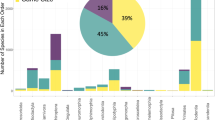Abstract
Among nonhuman primates, male reproductive skew (i.e., the distribution of reproductive success across males) appears to be affected primarily by receptive synchrony and the number of males per group. These factors have been assumed to depend on reproductive seasonality, with strong seasonality increasing receptive synchrony, which in turn reduces the strength of male monopolization associated with more males and lower skew. Here we tested the importance of reproductive seasonality for 26 populations representing 15 species living in multimale groups. We obtained data from the literature on paternity, number of males per group, receptive synchrony, and three measures of seasonality of reproduction. We analyzed these data using bivariate regressions and hierarchical regression by sets and controlled for the effect of evolutionary relationships using phylogenetic generalized least squares. As expected, alpha male paternity decreased as the number of males per group increased as well as with increasing female receptive synchrony. Reproductive seasonality did not explain variation in reproductive skew over and above the variation explained by synchrony and the number of males. Reproductive seasonality alone only explained a small proportion of the variation in skew, and there was no strong association between reproductive seasonality and synchrony. The effects of receptive synchrony and reproductive seasonality as well as their link were reduced if we excluded captive populations. These results indicate that across primates male reproductive skew is related to the number of competitors in a group and that seasonality does not reliably predict synchrony or male reproductive skew.



Similar content being viewed by others
References
Alberts SC, Buchan JC, Altmann J (2006) Sexual selection in wild baboons: from mating opportunities to paternity success. Anim Behav 72:1177–1196
Altmann SA (1962) A field study of the sociobiology of rhesus monkeys, Macaca mulatta. Ann Acad Sci 102:338–435
Altmann J, Alberts SC, Haines SA, Dubach J, Muruthi P, Coote T, Geffen E, Cheesman DJ, Mututua RS, Saiyalel SN, Wayne RK, Lacy RC, Bruford MW (1996) Behavior predicts genetic structure in a wild primate group. Proc Natl Acad Sci USA 93:5797–5801
Arnold C, Matthews LJ, Nunn CL (2010) The 10kTrees website: a new online resource for primate phylogeny. Evol Anthropol 19:114–118
Batschelet E (1981) Circular statistics in biology. Academic, London
Birkhead TR, Biggins JD (1987) Reproductive synchrony and extra-pair copulation in birds. Ethology 74:320–334
Boesch C, Kohou G, Néné H, Vigilant L (2006) Male competition and paternity in wild chimpanzees of the Tai forest. Am J Phys Anthropol 130:103–115
Borries C, Koenig A, Winkler P (2001) Variation of life history traits and mating patterns in female langur monkeys (Semnopithecus entellus). Behav Ecol Sociobiol 50:391–402
Brauch K, Hodges K, Engelhardt A, Fuhrmann K, Shaw E, Heistermann M (2008) Sex-specific reproductive behaviours and paternity in free-ranging Barbary macaques (Macaca sylvanus). Behav Ecol Sociobiol 62:1453–1466
Brockman DK, van Schaik CP (2005) Seasonality and reproductive function. In: van Schaik CP, Brockman DK (eds) Seasonality in primates: studies of living and extinct human and non-human primates. Cambridge University Press, New York, pp 269–305
Buston PM, Zink AG (2009) Reproductive skew and the evolution of conflict resolution: a synthesis of transactional and tug-of-war models. Behav Ecol 20:672–684
Buston PM, Reeve HK, Cant MA, Vehrencamp SL, Emlen ST (2007) Reproductive skew and the evolution of group dissolution tactics: a synthesis of concession and restraint models. Anim Behav 74:1643–1654
Cant MA (1998) A model for the evolution of reproductive skew without reproductive suppression. Anim Behav 55:163–169
Carnes LM, Nunn CL, Lewis RJ (2011) Effects of the distribution of female primates on the number of males. PLoS One 6:e19853
Clarke PMR, Henzi SP, Barrett L (2012) Estrous synchrony in a nonseasonal breeder: adaptive strategy or population process? Behav Ecol 23:573–581
Cooney R, Bennett NC (2000) Inbreeding avoidance and reproductive skew in a cooperative mammal. Proc R Soc B 267:801–806
Cowlishaw G, Dunbar RIM (1991) Dominance rank and mating success in male primates. Anim Behav 41:1045–1056
de Ruiter JR, van Hooff JARAM (1993) Male-dominance rank and reproductive success in primate groups. Primates 34:513–523
R Development Core Team (2012) R: a language and environment for statistical computing. Available from: http://www.R-project.org
Drent R, Daan S (1980) The prudent parent: energetic adjustments in avian breeding. Ardea 68:225–252
Dunbar RIM (2000) Male mating strategies: a modeling approach. In: Kappeler PM (ed) Primate males: causes and consequences of variation in group composition. Cambridge University Press, Cambridge, pp 259–268
Emlen ST, Oring LW (1977) Ecology, sexual selection, and the evolution of mating systems. Science 197:215–223
Felsenstein J (1988) Phylogenies from molecular sequences—inference and reliability. Annu Rev Genet 22:521–565
Freckleton RP, Harvey PH, Pagel M (2002) Phylogenetic analysis and comparative data: a test and review of evidence. Am Nat 160:712–726
French JA, Stribley JA (1987) Synchronization of ovarian cycles within and between social groups in golden lion tamarins (Leontopithecus rosalia). Am J Primatol 12:469–478
Fürtbauer I, Mundry R, Heistermann M, Schülke O, Ostner J (2011) You mate, I mate: macaque females synchronize sex not cycles. PLoS One 6:e26144
Garland T Jr, Ives AR (2000) Using the past to predict the present: confidence intervals for regression equations in phylogenetic comparative methods. Am Nat 155:346–364
Garland T Jr, Dickerman AW, Janis CM, Jones JA (1993) Phylogenetic analysis of covariance by computer simulation. Syst Biol 42:265–292
Gerloff U, Hartung B, Fruth B, Hohmann G, Tautz D (1999) Intracommunity relationships, dispersal pattern and paternity success in a wild living community of bonobos (Pan paniscus) determined from DNA analysis of faecal samples. Proc R Soc B 266:1189–1195
Hager R, Johnstone RA (2004) Infanticide and control of reproduction in cooperative and communal breeders. Anim Behav 67:941–949
Hager R, Jones C (2009) Reproductive skew in vertebrates: proximate and ultimate causes. Cambridge University Press, Cambridge
Hendrickx AG, Dukelow WR (1995) Reproductive biology. In: Bennett BT, Abee CR, Hendrickson R (eds) Nonhuman primates in biomedical research. Academic, San Diego, pp 147–191
Hohmann G, Gerloff U, Tautz D, Fruth B (1999) Social bonds and genetic ties: kinship, association and affiliation in a community of bonobos (Pan paniscus). Behaviour 136:1219–1235
Huck M, Löttker P, Böhle UR, Heymann EW (2005) Paternity and kinship patterns in polyandrous moustached tamarins (Saguinus mystax). Am J Phys Anthropol 127:449–464
Ims R (1988) Spatial clumping of sexually receptive females induces space sharing among male voles. Nature 335:541–543
Inoue M, Mitsunaga F, Ohsawa H, Takenaka A, Sugiyama Y, Soumah A, Takenaka O (1992) Paternity discrimination by DNA fingerprinting and male mating behavior in an enclosed Japanese macaque group. In: Itoigawa N, Sugiyama Y, Sackett G (eds) Topics in primatology, vol II: behavior, ecology and conservation. University of Tokyo Press, Tokyo, pp 35–45
Iossa G, Soulsbury CD, Baker PJ, Harris S (2008) Sperm competition and the evolution of testes size in terrestrial mammalian carnivores. Funct Ecol 22:655–662
Isvaran K, Clutton-Brock T (2007) Ecological correlates of extra-group paternity in mammals. Proc R Soc B 274:219–224
Janson C, Verdolin J (2005) Seasonality of primate births in relation to climate. In: van Schaik CP, Brockman DK (eds) Seasonality in primates: studies of living and extinct human and non-human primates. Cambridge University Press, New York, pp 307–350
Johnstone RA (2000) Models of reproductive skew: a review and synthesis. Ethology 106:5–26
Johnstone RA, Cant MA (1999) Reproductive skew and the threat of eviction: a new perspective. Proc R Soc B 266:275–279
Jönsson KI (1997) Capital and income breeding as alternative tactics of resource use in reproduction. Oikos 78:57–66
Kappeler PM, van Schaik CP (2002) Evolution of primate social systems. Int J Primatol 23:707–740
Koenig A, Borries C, Chalise M, Winkler P (1997) Ecology, nutrition, and timing of reproductive events in an Asian primate, the Hanuman langur (Presbytis entellus). J Zool 243:215–235
Kokko H, Mackenzie A, Reynolds JD, Lindström J, Sutherland WJ (1999) Measures of inequality are not equal. Am Nat 154:358–382
Kutsukake N, Nunn CL (2006) Comparative tests of reproductive skew in male primates: the roles of demographic factors and incomplete control. Behav Ecol Sociobiol 60:695–706
Launhardt K, Borries C, Hardt C, Epplen JT, Winkler P (2001) Paternity analysis of alternative male reproductive routes among the langurs (Semnopithecus entellus) of Ramnagar. Anim Behav 61:53–64
Li J, Han K, Xing J, Kim H, Rogers J, Ryder O, Disotell T, Yue B, Batzer M (2009) Phylogeny of the macaques (Cercopithecidae: Macaca) based on Alu elements. Gene 448:242–249
Lindburg DG (1987) Seasonality of reproduction in primates. In: Mitchell G, Erwin J (eds) Comparative primate biology, Vol 2, Part B: behavior cognition, and motivation. Alan R. Liss, New York, pp 167–218
Mass V, Heistermann M, Kappeler PM (2009) Mate-guarding as a male reproductive tactic in Propithecus verreauxi. Int J Primatol 30:389–409
McClintock M (1971) Menstrual synchrony and suppression. Nature 229:244–245
Mitani JC, Gros-Louis J, Manson JH (1996) Number of males in primate groups: comparative tests of competing hypotheses. Am J Primatol 38:315–332
Moscovice LR, Di Fiore A, Crockford C, Kitchen DM, Wittig R, Seyfarth RM, Cheney DL (2010) Hedging their bets? Male and female chacma baboons form friendships based on likelihood of paternity. Anim Behav 79:1007–1015
Nonacs P (2000) Measuring and using skew in the study of social behavior and evolution. Am Nat 156:577–589
Nonacs P (2003) Measuring the reliability of skew indices: is there one best index? Anim Behav 65:615–627
Nonacs P, Hager R (2011) The past, present and future of reproductive skew theory and experiments. Biol Rev 86:271–298
Nunn CL (1999) The number of males in primate social groups: a comparative test of the socioecological model. Behav Ecol Sociobiol 46:1–13
Orme D, Freckleton R, Thomas G, Petzoldt T, Fritz S, Nick I (2011) Caper: comparative analyses of phylogenetics and evolution in R. R package version 0.4. Available from: http://CRAN.R-project.org/package=caper
Ostner J, Nunn CL, Schülke O (2008) Female reproductive synchrony predicts skewed paternity across primates. Behav Ecol 19:1150–1158
Pagel M (1999) Inferring the historical patterns of biological evolution. Nature 401:877–884
Paradis E, Claude J, Strimmer K (2004) APE: analyses of phylogenetics and evolution in R language. Bioinformatics 20:289–290
Paul A (1997) Breeding seasonality affects the association between dominance and reproductive success in non-human male primates. Folia Primatol 68:344–349
Pereira ME (1991) Asynchrony within estrous synchrony among ringtailed lemurs (Primates: Lemuridae). Physiol Behav 49:47–52
Pereira ME (1998) One male, two males, three males, more. Evol Anthropol 7:39–45
Pereira ME, Clutton-Brock TM, Kappeler PM (2000) Understanding male primates. In: Kappeler PM (ed) Primate males: causes and consequences of variation in group composition. Cambridge University Press, Cambridge, pp 271–277
Port M, Kappeler PM (2010) The utility of reproductive skew models in the study of male primates, a critical evaluation. Evol Anthropol 19:46–56
Reeve HK, Emlen ST, Keller L (1998) Reproductive sharing in animal societies: reproductive incentives or incomplete control by dominant breeders? Behav Ecol 9:267–278
Ridley M (1986) The number of males in a primate troop. Anim Behav 34:1848–1858
Schwagmeyer PL, Ketterson ED (1999) Breeding synchrony and EPF rates: the key to a can of worms? Trends Ecol Evol 14:47–48
Setchell JM (2008) Alternative reproductive tactics in primates. In: Oliveira RF, Taborsky M, HJ B (eds) Alternative reproductive tactics: an integrative approach. Cambridge University Press, New York, pp 373–398
Shen SF, Reeve HK (2010) Reproductive skew theory unified: the general bordered tug-of-war model. J Theor Biol 263:1–12
Sokal RR, Rohlf FJ (1995) Biometry, 3rd edn. W. H, Freeman, New York
Streiner DL (2002) Breaking up is hard to do: the heartbreak of dichotomizing continuous data. Can J Psychiatry 47:262–266
Strier KB, Chaves PB, Mendes SL, Fagundes V, Di Fiore A (2011) Low paternity skew and the influence of maternal kin in an egalitarian, patrilocal primate. Proc Natl Acad Sci USA 108:18915–18919
Stutchbury BJ, Morton ES (1995) The effect of breeding synchrony on extra-pair mating systems in songbirds. Behaviour 132:675–690
Tosi AJ, Morales JC, Melnick DJ (2003) Paternal, maternal, and biparental molecular markers provide unique windows onto the evolutionary history of macaque monkeys. Evolution 57:1419–1435
van Horn RN (1975) Primate breeding season: photoperiodic regulation in captive Lemur catta. Folia Primatol 24:203–220
van Noordwijk MA, van Schaik CP (2004) Sexual selection and the careers of primate males: paternity concentration, dominance-acquisition tactics and transfer decisions. In: Kappeler PM, van Schaik CP (eds) exual selection in primates: new and comparative perspectives.Cambridge. University Press, New York, pp 208–229
van Schaik CP, Kappeler PM (1997) Infanticide risk and the evolution of male–female association in primates. Proc R Soc B 264:1687–1694
van Schaik CP, van Noordwijk MA (1985) Interannual variability in fruit abundance and the reproductive seasonality in Sumatran long-tailed macaques (Macaca fascicularis). J Zool 206:533–549
van Schaik CP, van Noordwijk MA, Nunn CL (1999) Sex and social evolution in primates. In: Lee PC (ed) Comparative primate socioecology. Cambridge University Press, Cambridge, pp 204–231
Vehrencamp SL (1979) The roles of individual, kin, and group selection in the evolution of sociality. In: Marler P, Vandenbergh JG (eds) Handbook of behavioral neurobiology: social behavior and communication. Plenum, New York, pp 351–394
Vehrencamp SL (1983) Optimal degree of skew in cooperative societies. Am Zool 23:327–335
Wallis J (1985) Synchrony of estrous swelling in captive group-living chimpanzees (Pan troglodytes). Int J Primatol 6:335–350
Weller A, Weller L (1993) Menstrual synchrony between mothers and daughters and between roommates. Physiol Behav 53:943–949
Witt R, Schmidt C, Schmitt J (1981) Social rank and Darwinian fitness in a multimale group of barbary macaques (Macaca sylvana Linnaeus, 1758): dominance reversals and male reproductive success. Folia Primatol 36:201–211
Acknowledgments
We thank Carola Borries, Leone Brown, Diane Doran-Sheehy, James Herrera, and Charles Nunn as well as Peter Henzi and two anonymous reviewers for suggestions and discussions. We are especially grateful to Diane Doran-Sheehy who suggested checking for the influence of captivity. We are thankful to Wolfgang Dittus and Becca Lewis for their help with the data. For training in phylogenetic comparative methods, we thank the AnthroTree Workshop (supported by NSF BCS-0923791). While conducting this study, Jan F. Gogarten was supported by a Graduate Research Fellowship from the National Science Foundation (Grant number: DGE-1142336).
Author information
Authors and Affiliations
Corresponding author
Additional information
Communicated by P. M. Kappeler
Electronic supplementary material
Below is the link to the electronic supplementary material.
ESM 1
(PDF 138 kb)
Rights and permissions
About this article
Cite this article
Gogarten, J.F., Koenig, A. Reproductive seasonality is a poor predictor of receptive synchrony and male reproductive skew among nonhuman primates. Behav Ecol Sociobiol 67, 123–134 (2013). https://doi.org/10.1007/s00265-012-1432-2
Received:
Revised:
Accepted:
Published:
Issue Date:
DOI: https://doi.org/10.1007/s00265-012-1432-2




